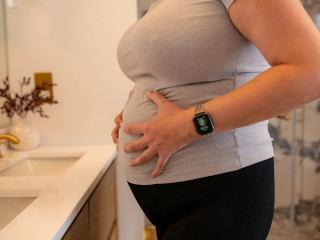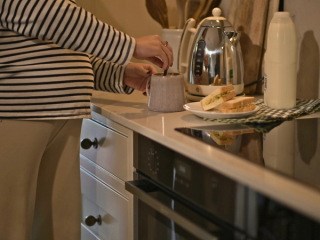
- Home
- Advice Hub
- Pregnancy
- Pregnancy Symptoms & Issues
- What Is Preeclampsia In Pregnancy?
What is preeclampsia in pregnancy?
Preeclampsia in pregnancy is a serious condition that causes high blood pressure, usually after 20 weeks or shortly after birth. Learn symptoms and care.
How common is preeclampsia?
Early signs and symptoms of preeclampsia
When to seek medical help
What causes preeclampsia?
Who is most at risk for preeclampsia?
How preeclampsia is diagnosed
How preeclampsia is treated
When will you need to deliver?
Can preeclampsia cause complications?
What to expect after delivery
Emotional impact and support
FAQs around preeclampsia
Preeclampsia in pregnancy is a condition in which a woman has persistent high blood pressure that usually presents after 20 weeks of pregnancy or in the postpartum period. It can be associated with high levels of protein in the urine, a new onset of decreased blood platelets, kidneys or liver issues, and visual disturbances. Prompt diagnosis and management are imperative to prevent it from developing into eclampsia, which involves seizures. Both conditions pose significant life-threatening risks.
How common is preeclampsia?
Preeclampsia is relatively uncommon, affecting an estimated 2% to 8% of pregnancies worldwide. There are approximately 46,000 maternal deaths due to preeclampsia each year and around 500,000 fetal or newborn deaths. Global and regional causes of maternal deaths 2009–20: a WHO systematic analysis. Lancet Glob Health. 2025.
While the vast majority of pregnancies are not impacted, it's crucial to be aware of the signs as preeclampsia is a potentially life-threatening condition and requires monitoring if diagnosed. My experience as a midwife has shown me that staying informed is your best defence. We routinely check for it at your antenatal and postnatal appointments, so you don't need to worry about missing it.
Early signs and symptoms of preeclampsia
Sometimes, the earliest signs of preeclampsia in pregnancy are subtle and can be easily missed. This is why regular antenatal check-ups are so important.
Symptoms you may not notice
The two main indicators of preeclampsia, high blood pressure and protein in your urine, are often discovered during your routine antenatal checks. You may not have any physical symptoms at all. This is why a midwife or doctor will measure your blood pressure and test a urine sample at every appointment.
Warning signs to look out for:
While some signs may not be obvious, others require immediate attention. If you experience any of the following, you must contact a healthcare professional immediately:
- Severe headaches that don't go away with simple over the counter painkillers
- Vision changes, such as blurred vision, seeing flashing lights or spots, or temporary loss of sight
- Pain just below the ribs or in the upper abdomen
- Sudden swelling of the face, hands, or feet
- Feeling generally unwell or "not right"
When to seek medical help
My most important piece of advice is: trust your instincts. If you feel something isn't right, or you notice any of the warning signs for preeclampsia, don't hesitate. Call your local maternity unit, Midwife, GP, or NHS 111 right away. Preeclampsia, if diagnosed, can be life-threatening, it's always better to be cautious and get checked out. Asking questions is key to staying safe.
You can find a list of helpful questions to ask your Midwife here.
What causes preeclampsia?
What causes preeclampsia in pregnancy isn't fully understood. However, it's widely believed to be linked to problems with the placenta, the organ that connects the mother's blood supply to the baby's. It's thought that the blood vessels in the placenta don't develop correctly, which can restrict blood flow and lead to high blood pressure and other issues associated with preeclampsia. There may be genetic factors involved, as we know that the condition often runs in families.
Who is most at risk for preeclampsia?
While anyone can develop preeclampsia, some factors can increase your risk. It's also important to note that having a risk factor does not always mean that you will get preeclampsia.
The Royal College of Obstetricians and Gynaecologists (RCOG) have divided the risk factors into two categories: High Risk and Moderate Risk
High Risk
- Pre-existing medical conditions: Such as diabetes, kidney disease, lupus, antiphospholipid syndrome or high blood pressure before pregnancy.
- Preeclampsia in a previous pregnancy
Moderate Risk
- Age: Being over the age of 40.
- First time pregnancies
- Obesity: A pre pregnancy BMI of 35 or more
- Your last pregnancy was more than 10 years ago
- Multiple pregnancies: Carrying twins or triplets.
- Family history: A mother or sister who has had preeclampsia.
- Assisted Reproductive Technology (ART)
If you have two or more high risk factors for preeclampsia, your midwife or doctor will recommend a daily low dose (75mg - 150mg) of aspirin starting from the 12th week of pregnancy until you give birth.
How preeclampsia is diagnosed
Diagnosing preeclampsia is a straightforward process based on routine checks. Your Midwife or doctor will:
- Measure your blood pressure. A reading of 140/90 mmHg or higher on two separate occasions, at least four hours apart, is considered high.
- Test your urine for protein.
- Conduct blood tests to check for liver and kidney function and a low platelet count.
- They will also perform ultrasound scans and dopplers to monitor the baby's growth and blood flow to the placenta.
How preeclampsia is treated
The treatment for preeclampsia depends on how severe it is and how far along you are in your pregnancy. It often involves:
- Hospital monitoring: You'll likely be admitted to the hospital for close observation of both you and your baby. This will involve blood tests, ultrasound scans, regular blood pressure monitoring and monitoring of your baby’s heartbeat.
- Medication: Your doctor may prescribe medications to lower your blood pressure. The goal is to prevent it from getting so dangerously high that it would cause a seizure. Magnesium sulphate is another medication that is given to prevent seizures.
- Early delivery: In some severe cases, the only way to cure preeclampsia is to deliver the baby. If a preterm delivery is anticipated, your doctor will offer you steroids to help mature your baby’s immature lungs.
When will you need to deliver?
Delivery is the only definitive cure for preeclampsia. For many, this happens around 37-38 weeks of pregnancy. The timing depends on how well the condition is managed. If the symptoms worsen or if there's a risk to the mother or baby, doctors may recommend an earlier delivery. In those moments, it's vital to have open communication with your healthcare team.
Here's how to talk to healthcare professionals effectively. To help you prepare, we also have a guide on labour and birth.
Can preeclampsia cause complications?
While most cases are managed safely, preeclampsia can lead to complications if not treated. The most serious complication is eclampsia, which involves seizures. Other potential issues include organ damage (liver, kidneys), blood clotting problems, or growth problems for the baby due to poor blood flow. However, with proper management, these are rare.
What to expect after delivery
After the baby’s birth, the symptoms of preeclampsia typically begin to improve quickly. You'll continue to be monitored for a while, but most women make a full recovery. It's normal to feel exhausted and overwhelmed. The fourth trimester is a real thing, and it's essential to rest and recover.
Emotional impact and support
Dealing with a serious pregnancy complication like preeclampsia can be emotionally draining and frightening. It's okay to feel this way. Please don't hesitate to reach out for support. Talk to your partner, family, or friends. Your Midwife or GP can also provide guidance on local support groups or mental health resources.
FAQs around preeclampsia
The main symptoms include high blood pressure, swelling of the face, hands, or feet, severe headaches, vision problems, and pain below the ribs. In some cases, there are no noticeable symptoms.
It most commonly develops after 20 weeks of pregnancy, particularly in the third trimester. It can also occur in the days or weeks following birth. Can preeclampsia happen in early pregnancy? Yes, although it is extremely rare.
Yes, with early detection and careful medical management, most babies do well. The key to a good outcome is the timing of delivery, which is carefully decided by doctors to ensure the best possible health for both you and your baby.
The exact cause is unknown, but it's believed to be linked to problems with the placenta. When blood flow to the placenta is affected, it can lead to high blood pressure and other issues associated with the condition.










